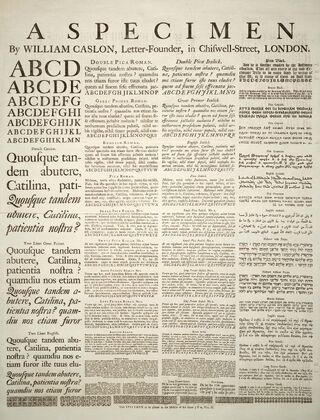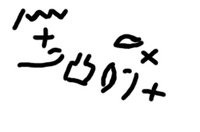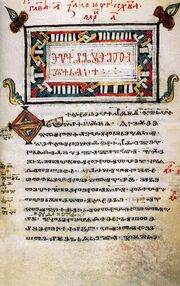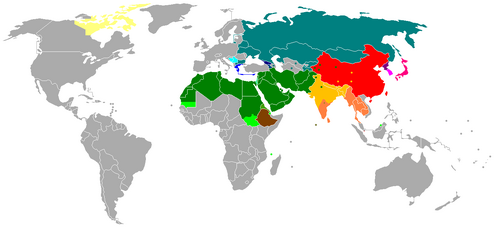| Line 129: | Line 129: | ||
* [[Akshara]] |
* [[Akshara]] |
||
* [[Alphabet Effect]] |
* [[Alphabet Effect]] |
||
| + | * [[Alphabetic principle]] |
||
* [[Alphabetical order]] |
* [[Alphabetical order]] |
||
* [[Collation]] |
* [[Collation]] |
||
Revision as of 08:01, 22 January 2009
Assessment |
Biopsychology |
Comparative |
Cognitive |
Developmental |
Language |
Individual differences |
Personality |
Philosophy |
Social |
Methods |
Statistics |
Clinical |
Educational |
Industrial |
Professional items |
World psychology |
Language: Linguistics · Semiotics · Speech

A Specimen of typeset fonts and languages, by William Caslon, letter founder; from the 1728 Cyclopaedia.
An alphabet can be thought of as one of two varities. Most popular one widely used around the world arbitarily assigns symbols for phonemes or group of phonemes. The second definition, also called ezuthu (eg, Tamil), assigns symbols for each physical place of articulation and scales these symbols into related groups of phonemes. An alphabet is a complete standardized set of letters — basic written symbols — each of which roughly represents a phoneme of a spoken language, either as it exists now or as it may have been in the past. There are other systems of writing such as logosyllabic writing, in which each symbol represents a morpheme, or word or syllable or places the word within a category, and syllabaries, in which each symbol represents a syllable.
The etymology of the word "alphabet" itself comes to Middle English from the Late Latin Alphabetum which in turn originates from the Ancient Greek Alphabetos, from alpha and beta, the first two letters of the Greek alphabet.[1] There are dozens of alphabets in use today. Most of them are 'linear', which means that they are made up of lines. Notable exceptions are Braille, manual alphabets, and Morse code.
Linguistic definition and context
 Writing systems |
|---|
| History |
| Grapheme |
| List of writing systems |
| Types |
| Alphabet |
| Abjad |
| Abugida |
| Syllabary |
| Logogram-based |
| Related |
| Pictogram |
| Ideogram |
The term alphabet refers to a writing system that has graphemes for representing both consonant and vowel sounds, even though there may not be a complete one-to-one correspondence between symbol and sound.
A grapheme is an abstract entity which may be physically represented by different styles of glyphs. There are many written entities which do not form part of the alphabet, including numerals, mathematical symbols, and punctuation. Some human languages are commonly written by using a combination of logograms (which represent morphemes or words) and syllabograms instead of an alphabet. Egyptian hieroglyphs and Chinese characters are two of the best-known writing systems with predominantly non-alphabetic representations.
Non-written languages may also be represented alphabetically. For example, linguists researching a non-written language (such as some of the indigenous Amerindian languages) will use the International Phonetic Alphabet to enable them to write down the sounds they hear.
Most, if not all, linguistic writing systems have some means for phonetic approximation of foreign words, usually using the native character set.[2]
History
- Main article: History of the alphabet
Middle Eastern Scripts

A specimen of Proto-Sinaitic script, one of the earliest (if not the very first) phonemic scripts
The history of the alphabet starts in ancient Egypt. By 2700 BCE Egyptian writing had a set of some 22 hieroglyphs to represent syllables that begin with a single consonant of their language, plus a vowel (or no vowel) to be supplied by the native speaker. These glyphs were used as pronunciation guides for logograms, to write grammatical inflections, and, later, to transcribe loan words and foreign names.[3]
However, although seemingly alphabetic in nature, the original Egyptian uniliterals were not a system and were never used by themselves to encode Egyptian speech.[4] In the Middle Bronze Age an apparently "alphabetic" system known as the Proto-Sinaitic script is thought by some to have been developed in central Egypt around 1700 BCE for or by Semitic workers, but only one of these early writings has been deciphered and their exact nature remains open to interpretation.[5] Based on letter appearances and names, it is believed to be based on Egyptian hieroglyphs.[5]
This script eventually developed into the Proto-Canaanite alphabet, which in turn was refined into the Phoenician alphabet.[6] Note that the scripts mentioned above are not considered proper alphabets, as they all lack characters representing vowels. These early vowelless alphabets are called abjads, and still exist in scripts such as the Arabic and Hebrew scripts.
Phoenician was the first major phonemic script.[7][8] In contrast to two other widely used writing systems at the time, Cuneiform and Egyptian hieroglyphs, each of which contained thousands of different characters, it contained only about two dozen distinct letters, making it a script simple enough for common traders to learn. Another advantage to Phoenician was that it could be used to write down many different languages, since it recorded words phonemically.
The script was spread by the Phoenicians, whose Thalassocracy allowed the script to be spread across the Mediterranean.[7] In Greece, the script was modified to add the vowels, giving rise to the first true alphabet. The Greeks took letters which did not represent sounds that existed in Greek, and changed them to represent the vowels. This marks the creation of a "true" alphabet, with the presence of both vowels and consonants as explicit symbols in a single script. In its early years, there were many variants of the Greek alphabet, a situation which caused so many different alphabets to evolve from it.
European alphabets

Codex Zographensis in the Glagolitic alphabet from Medieval Bulgaria.
The Cumae form was carried over to the Italian peninsula, where it gave way to a variety of alphabets used to inscribe the Italic languages. One of these became the Latin alphabet, which was spread across Europe as the Romans expanded their empire. Even after the fall of the Roman state, the alphabet survived in intellectual and religious works. It eventually became used for the descendant languages of Latin (the Romance languages), and then for the other languages of Europe.
Another notable script is Elder Futhark, and is believed to have evolved out of one of the Old Italic alphabets. Elder Futhark gave rise to a variety of alphabets known collectively as the Runic alphabets. The Runic alphabets were used for Germanic languages from 100 AD to the late middle ages. Its usage was mostly restricted to engravings on stone and jewelry, although inscriptions have also been found on bone and wood. These alphabets have since been replaced with the Latin alphabet, except for decorative usage for which the runes remained in use until the 20th century.
The Glagolitic alphabet was the script of the liturgical language Old Church Slavonic, and became the basis of the Cyrillic alphabet. The Cyrillic alphabet is one of the most widely used modern alphabets, and is notable for its use in Slavic languages and languages formerly part of the Soviet Union, such as the Bulgarian and Russian alphabets. The Glagolitic alphabet is believed to have been created by Saints Cyril and Methodius, while the Cyrillic alphabet was invented by the Bulgarian scholar Clement of Ohrid, who was their disciple. They feature many letters that appear to have been borrowed from or influenced by the Greek alphabet and the Hebrew alphabet.
Asian alphabets
Beyond the logographic Chinese writing, many phonetic scripts are in existence in Asia. The Arabic alphabet, Hebrew alphabet, Syriac alphabet, and other abjads of the Middle East are developments of the Aramaic alphabet, but because these writing systems are largely consonant-based they are often not considered true alphabets.
Most alphabetic scripts of India and Eastern Asia are descended from the Brahmi script, which is often believed to be a descendent of Aramaic, but this link is controversial. These scripts are abugidas, that is, they write syllables instead of individual sounds, so their status as alphabets is disputed.

Zhuyin on a cell phone
In Korea, the Hangeul alphabet was created, although it may also have been derived from the Mongolian Phagspa script, which in turn was derived from the Brahmi script. Hangeul is a unique alphabet in a variety of ways: many of the letters are designed off of a sound's place of articulation, it was consciously designed by the government at the time, and it situates individual letters into syllable clusters with equal dimensions as Chinese characters to allow for mixed script writing.
Zhuyin (sometimes called Bopomofo) is an alphabet used to phonetically transcribe Mandarin Chinese in Mainland China and Taiwan, though its use in Mainland China today is limited. It developed out of a form of Chinese shorthand based on Chinese characters in the early 1900s. While Zhuyin is not used as a mainstream writing system, it is still often used in ways similar to a romanization system—that is, for aiding in pronunciation and as an input method for Chinese characters on computers and cell phones.
European alphabets, especially Latin and Cyrillic, have been adapted for many languages of Asia. Arabic is also widely used, sometimes as an abjad (as with Urdu and Persian) and sometimes as a complete alphabet (as with Kurdish and Uyghur).
Types

Alphabets: Latin , Cyrillic , Latin and Cyrillic , Greek , Georgian or Armenian
Abjads: Arabic , Arabic and Latin , Hebrew and Arabic
Abugidas: North Indic , South Indic , Ethiopic , Thaana Canadian Syllabic ,
Logographic+syllabic: Pure logographic , Mixed logographic and syllabaries , Featural-alphabetic syllabary + limited logographic Featural-alphabetic syllabary
| History of the alphabet |
|---|
|
Middle Bronze Age 19th c. BC
|
| Meroitic 3rd c. BC |
| Hangul 1443 |
| Canadian Syllabics 1840 |
| Zhuyin 1913 |
| complete genealogy |
The term "alphabet" is used by linguists and paleographers in both a wide and narrow sense. In the wider sense, an alphabet is a script that is segmental on the phoneme level, that is, that has separate glyphs for individual sounds and not for larger units such as syllables or words. In the narrower sense, some scholars distinguish "true" alphabets from two other types of segmental script, abjads and abugidas. These three differ from each other in the way they treat vowels: Abjads have letters for consonants and leave most vowels unexpressed; abugidas are also consonant-based, but indicate vowels with diacritics to or a systematic graphic modification of the consonants. In alphabets in the narrow sense, on the other hand, consonants and vowels are written as independent letters. The earliest known alphabet in the wider sense is the Wadi el-Hol script, believed to be an abjad, which through its successor Phoenician is the ancestor of modern alphabets, including Arabic, Greek, Latin (via the Old Italic alphabet), Cyrillic (via the Greek alphabet) and Hebrew (via Aramaic).
Examples of present-day abjads are the Arabic and Hebrew scripts; true alphabets include Latin, Cyrillic, and Korean Hangul; and abugidas are used to write Tigrinya Amharic, Hindi, and Thai. The Canadian Aboriginal Syllabics are also an abugida rather than a syllabary as their name would imply, since each glyph stands for a consonant which is modified by rotation to represent the following vowel. (In a true syllabary, each consonant-vowel combination would be represented by a separate glyph.)
The boundaries between the three types of segmental scripts are not always clear-cut. For example, Iraqi Kurdish is written in the Arabic script, which is normally an abjad. However, in Kurdish, writing the vowels is mandatory, and full letters are used, so the script is a true alphabet. Other languages may use a Semitic abjad with mandatory vowel diacritics, effectively making them abugidas. On the other hand, the Phagspa script of the Mongol Empire was based closely on the Tibetan abugida, but all vowel marks were written after the preceding consonant rather than as diacritic marks. Although short a was not written, as in the Indic abugidas, one could argue that the linear arrangement made this a true alphabet. Conversely, the vowel marks of the Tigrinya abugida and the Amharic abugida (ironically, the original source of the term "abugida") have been so completely assimilated into their consonants that the modifications are no longer systematic and have to be learned as a syllabary rather than as a segmental script. Even more extreme, the Pahlavi abjad eventually became logographic. (See below.)
Thus the primary classification of alphabets reflects how they treat vowels. For tonal languages, further classification can be based on their treatment of tone, though names do not yet exist to distinguish the various types. Some alphabets disregard tone entirely, especially when it does not carry a heavy functional load, as in Somali and many other languages of Africa and the Americas. Such scripts are to tone what abjads are to vowels. Most commonly, tones are indicated with diacritics, the way vowels are treated in abugidas. This is the case for Vietnamese (a true alphabet) and Thai (an abugida). In Thai, tone is determined primarily by the choice of consonant, with diacritics for disambiguation. In the Pollard script, an abugida, vowels are indicated by diacritics, but the placement of the diacritic relative to the consonant is modified to indicate the tone. More rarely, a script may have separate letters for tones, as is the case for Hmong and Zhuang. For most of these scripts, regardless of whether letters or diacritics are used, the most common tone is not marked, just as the most common vowel is not marked in Indic abugidas.
The number of different letters in an alphabet can be quite small. The Book Pahlavi script, an abjad, had only twelve letters at one point, and may have had even fewer later on. Today the Rotokas alphabet has only twelve letters. (The Hawaiian alphabet is sometimes claimed to be as small, but it actually consists of 18 letters, including the ʻokina and five long vowels.) While Rotokas has a small alphabet because it has few phonemes to represent (just eleven), Book Pahlavi was small because many letters had been conflated, that is, the graphic distinctions had been lost over time, and diacritics were not developed to compensate for this as they were in Arabic, another script that lost many of its distinct letter shapes. For example, a comma-shaped letter represented g, d, y, k, or j. However, such apparent simplifications can perversely make a script more complicated. In later Pahlavi papyri, up to half of the remaining graphic distinctions of these twelve letters were lost, and the script could no longer be read as a sequence of letters at all, but instead each word had to be learned as a whole – that is, they had become logograms as in Egyptian Demotic.
The largest segmental script is probably an abugida, Devanagari. When written in Devanagari, Vedic Sanskrit has an alphabet of 53 letters, including the visarga mark for final aspiration and special letters for kš and jñ, though one of the letters is theoretical and not actually used. The Hindi alphabet must represent both Sanskrit and modern vocabulary, and so has been expanded to 58 with the khutma letters (letters with a dot added) to represent sounds from Persian and English.
The largest known abjad is Sindhi, with 51 letters. The largest alphabets in the narrow sense include Kabardian and Abkhaz (for Cyrillic), with 58 and 56 letters, respectively, and Slovak (for the Latin alphabet), with 46. However, these scripts either count di- and tri-graphs as separate letters, as Spanish did with ch and ll up to a recent time, or uses diacritics like Slovak č. The largest true alphabet where each letter is graphically independent is probably Georgian, with 41 letters.
Syllabaries typically contain 50 to 400 glyphs (though the Múra-Pirahã language of Brazil would require only 24 if it did not denote tone, and Rotokas would require only 30), and the glyphs of logographic systems typically number from the many hundreds into the thousands. Thus a simple count of the number of distinct symbols is an important clue to the nature of an unknown script.
It is not always clear what constitutes a distinct alphabet. French uses the same basic alphabet as English, but many of the letters can carry additional marks, such as é, à, and ô. In French, these combinations are not considered to be additional letters. However, in Icelandic, the accented letters such as á, í, and ö are considered to be distinct letters of the alphabet. In Spanish, ñ is considered a separate letter, but accented vowels such as á and é are not. Some adaptations of the Latin alphabet are augmented with ligatures, such as æ in Old English and Ȣ in Algonquian; by borrowings from other alphabets, such as the thorn þ in Old English and Icelandic, which came from the Futhark runes; and by modifying existing letters, such as the eth ð of Old English and Icelandic, which is a modified d. Other alphabets only use a subset of the Latin alphabet, such as Hawaiian, or Italian, which only uses the letters j, k, x, y and w in foreign words.
Spelling
- For more details on this topic, see Spelling.
Each language may establish certain general rules that govern the association between letters and phonemes, but, depending on the language, these rules may or may not be consistently followed. In a perfectly phonological alphabet, the phonemes and letters would correspond perfectly in two directions: a writer could predict the spelling of a word given its pronunciation, and a speaker could predict the pronunciation of a word given its spelling. However, languages often evolve independently of their writing systems, and writing systems have been borrowed for languages they were not designed for, so the degree to which letters of an alphabet correspond to phonemes of a language varies greatly from one language to another and even within a single language.
Languages may fail to achieve a one-to-one correspondence between letters and sounds in any of several ways:
- A language may represent a given phoneme with a combination of letters rather than just a single letter. Two-letter combinations are called digraphs and three-letter groups are called trigraphs. German uses the tesseragraphs (four letters) "tsch" for the phoneme [tʃ] and "dsch" for [dʒ], although, the latter is rare (IPA). Kabardian also uses a tesseragraph for one of its phonemes.
- A language may represent the same phoneme with two different letters or combinations of letters.
- A language may spell some words with unpronounced letters that exist for historical or other reasons.
- Pronunciation of individual words may change according to the presence of surrounding words in a sentence (sandhi).
- Different dialects of a language may use different phonemes for the same word.
- A language may use different sets of symbols or different rules for distinct sets of vocabulary items, such as the Japanese hiragana and katakana syllabaries, or the various rules in English for spelling words from Latin and Greek, or the original Germanic vocabulary.
National languages generally elect to address the problem of dialects by simply associating the alphabet with the national standard. However, with an international language with wide variations in its dialects, such as English, it would be impossible to represent the language in all its variations with a single phonetic alphabet.
Some national languages like Finnish have a very regular spelling system with a nearly one-to-one correspondence between letters and phonemes. The Italian verb corresponding to 'spell', compitare, is unknown to many Italians because the act of spelling itself is almost never needed: each phoneme of Standard Italian is represented in only one way. However, pronunciation cannot always be predicted from spelling because certain letters are pronounced in more than one way. In standard Spanish, it is possible to tell the pronunciation of a word from its spelling, but not vice versa; this is because certain phonemes can be represented in more than one way, but a given letter is consistently pronounced. French, with its silent letters and its heavy use of nasal vowels and elision, may seem to lack much correspondence between spelling and pronunciation, but its rules on pronunciation are actually consistent and predictable with a fair degree of accuracy.
At the other extreme, however, are languages such as English, where the spelling of many words simply has to be memorized as they do not correspond to sounds in a consistent way. For English, this is because the Great Vowel Shift occurred after the orthography was established, and because English has acquired a large number of loanwords at different times retaining their original spelling at varying levels. However, even English has general rules that predict pronunciation from spelling, and these rules are successful most of the time.
Sometimes, countries have the written language undergo a spelling reform in order to realign the writing with the contemporary spoken language. These can range from simple spelling changes and word forms to switching the entire writing system itself, as when Turkey switched from the Arabic alphabet to the Roman alphabet.
The sounds of speech of all languages of the world can be written by a rather small universal phonetic alphabet. A standard for this is the International Phonetic Alphabet.
See also
- Abecedarium
- Akshara
- Alphabet Effect
- Alphabetic principle
- Alphabetical order
- Collation
- Artificial scripts
- Character set
- Initial teaching alphabet
- Letters (alphabet)
- Lipogram
- List of alphabets
- Orthography
Notes
- ↑ Encyclopædia Britannica Online - Merriam-Webster's Online Dictionary
- ↑ Ohso, Mieko (April 1973). A Phonological Study of Some English Loan Words in Japanese. Working Papers in Linguistics, No. 14, Studies in Phonology and Methodology. Studies in Phonology and Methodology (14): 27 pages. ERIC # ED122593.
- ↑ Daniels and Bright (1996), pp. 74-75.
- ↑ Daniels and Bright (1996), pp. 74.
- ↑ 5.0 5.1 Coulmas (1989), p. 140.
- ↑ Daniels and Bright (1996), pp. 92-94.
- ↑ 7.0 7.1 Daniels and Bright (1996), pp. 94-96.
- ↑ Coulmas (1989), p. 141.
Footnotes
Bibliography
- Daniels, Peter T.; Bright, William (1996). The World's Writing Systems, Oxford University Press. ISBN 0-19-507993-0. — (Overview of modern and some ancient writing systems).
- Driver, G.R. (1976). Semitic Writing (Schweich Lectures on Biblical Archaeology S.) 3Rev Ed, Oxford University Press. ISBN 0-19-725917-0.
- Hoffman, Joel M. (2004). In the Beginning: A Short History of the Hebrew Language, NYU Press. ISBN 0-8147-3654-8. — (Chapter 3 traces and summarizes the invention of alphabetic writing).
- Logan, Robert K. (2004). The Alphabet Effect: A Media Ecology Understanding of the Making of Western Civilization, Hampton Press. ISBN 1-57-273523-6.
- McLuhan, Marshall; Logan, Robert K. (1977). Alphabet, Mother of Invention. Etcetera. Vol. 34, pp. 373-383.
- Ouaknin, Marc-Alain; Bacon, Josephine (1999). Mysteries of the Alphabet: The Origins of Writing, Abbeville Press. ISBN 0-7892-0521-1.
- Sacks, David (2004). Letter Perfect: The Marvelous History of Our Alphabet from A to Z, Broadway Books. ISBN 0-7679-1173-3.
- Saggs, H.W.F (1991). Civilization Before Greece and Rome, Yale University Press. ISBN 0-300-05031-3. — (Chapter 4 traces the invention of writing).
- Coulmas, Florian (1989). The Writing Systems of the World, Blackwell Publishers Ltd.. ISBN 0-631-18028-1.
References & Bibliography
Key texts
Books
Papers
Additional material
Books
Papers
External links
Look up this page on
Wiktionary:
alphabet
- Alphabetic Writing Systems
- Michael Everson's Alphabets of Europe
- The Unicode Consortium
- Evolution of alphabets animation by Prof. Robert Fradkin at the University of Maryland
- History of alphabet
- The Hebrew Alphabet
- American Sign Language alphabet A free online tool to help you learn fingerspelling (dactylology). Also see: ASL Slider
| This page uses Creative Commons Licensed content from Wikipedia (view authors). |